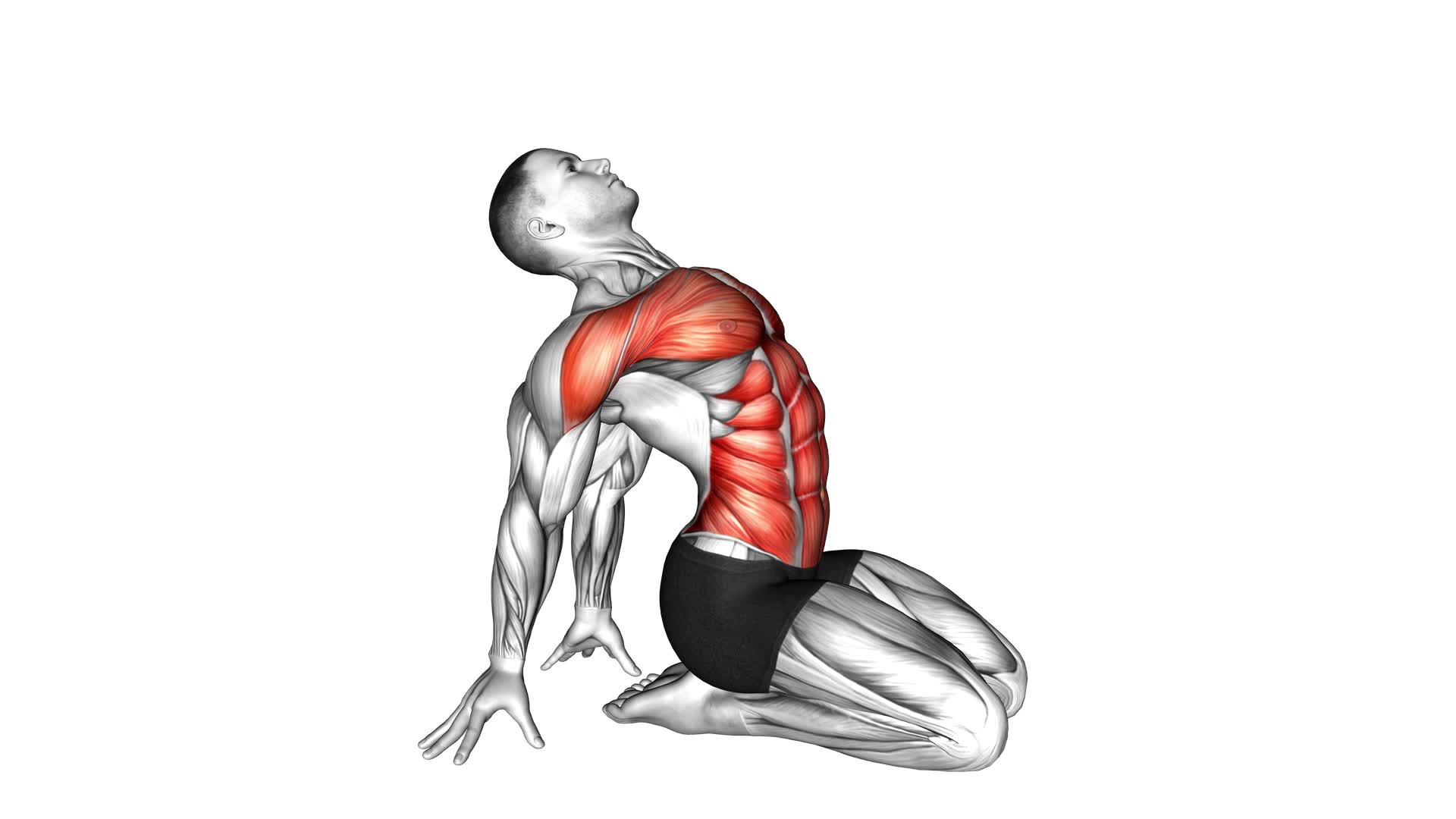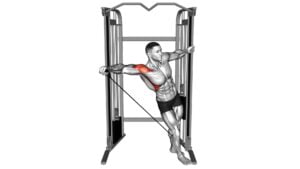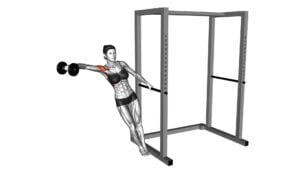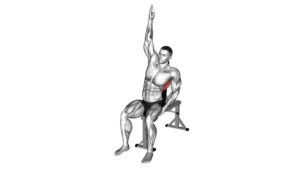Seated Leaning Back Stretch – Video Exercise Guide & Tips

Are you looking for an effective stretch to relieve tension and improve flexibility? Look no further than the seated leaning back stretch.
Watch This Exercise Video
In this video exercise guide, we'll show you the proper form and technique to get the most out of this stretch.
Whether you're a beginner or a fitness enthusiast, we've got modifications to suit your needs.
Get ready to incorporate the seated leaning back stretch into your routine and experience the benefits for yourself.
Key Takeaways
- Activates core muscles
- Improves flexibility
- Strengthens abdominal muscles, obliques, and lower back
- Enhances overall stability and posture
Benefits of the Seated Leaning Back Stretch
The seated leaning back stretch offers several benefits for your body and can be a great addition to your exercise routine. This stretch isn't only effective in activating your core muscles but also in improving your flexibility.
By leaning back in a seated position, you engage your abdominal muscles, obliques, and lower back, which helps to strengthen your core. This is particularly beneficial for improving your overall stability and posture.
In addition to core activation, the seated leaning back stretch also promotes flexibility improvement. When you lean back, you stretch your hip flexors, which can become tight from prolonged sitting or physical activity. By regularly incorporating this stretch into your routine, you can increase the range of motion in your hips and improve your overall flexibility.
To ensure you're getting the maximum benefits from this stretch, it's important to focus on proper form and technique. This will help you avoid any potential injuries and ensure that you're targeting the intended muscle groups.
Proper Form and Technique
To ensure proper form and technique during the Seated Leaning Back Stretch, it's crucial to pay attention to back alignment. Keep your spine straight and avoid slouching to maximize the benefits of the stretch.
Additionally, engaging your core muscles is essential for stability and to prevent strain on the lower back. Be mindful of common form mistakes such as rounding the shoulders or arching the lower back, as these can lead to discomfort or injury.
Back Alignment Tips
Maintain proper back alignment by engaging your core muscles while performing the seated leaning back stretch. This exercise isn't only beneficial for back pain relief but also for posture improvement.
To ensure proper form and technique, start by sitting upright with your feet flat on the ground. Keep your spine straight, shoulders relaxed, and chin slightly tucked in.
As you lean back, focus on engaging your abdominal muscles to support your lower back. Avoid arching your back or straining your neck. Remember to breathe deeply and relax into the stretch.
Core Engagement Importance
Start by engaging your core muscles to maintain proper form and technique during the seated leaning back stretch. Core activation is essential for a strong and stable foundation, allowing you to perform exercises safely and effectively.
Strengthening your core muscles not only improves your posture but also enhances your overall athletic performance. Here are three reasons why core engagement is important:
- Stability: Engaging your core muscles creates a stable base, preventing excessive movement and reducing the risk of injury.
- Balance: A strong core helps improve your balance and coordination, enabling you to maintain control during movements.
- Power transfer: When your core is engaged, it acts as a transfer point for force, allowing you to generate more power in your workouts.
Incorporating core activation exercises into your routine can help you achieve better results and optimize your overall fitness level.
Common Form Mistakes
You can avoid common form mistakes by focusing on proper form and technique during the seated leaning back stretch. It's important to maintain the correct posture throughout the exercise to avoid injury and maximize the benefits.
One common mistake is rounding your back instead of keeping it straight. To correct this, engage your core muscles and imagine lengthening your spine.
Another mistake is leaning too far back, which can strain your lower back. Instead, aim for a comfortable stretch that allows you to maintain control and stability.
Additionally, be mindful of any back stretch modifications that may be necessary for your individual needs or limitations.
Common Mistakes to Avoid
To avoid common mistakes during the seated leaning back stretch, remember to keep your lower back supported and engage your core muscles. Here are three common mistakes to avoid when performing this exercise:
- Slouching: One of the most common mistakes people make during back stretching exercises is slouching. Slouching not only reduces the effectiveness of the stretch but also puts unnecessary strain on your lower back. Remember to sit up tall and maintain proper posture throughout the exercise.
- Overarching the back: While it's important to lean back during this stretch, be careful not to overarch your back. Overarching can strain your lower back and lead to discomfort or injury. Instead, focus on maintaining a gentle and controlled lean.
- Neglecting core engagement: Engaging your core muscles is crucial for proper form and effective stretching. By activating your core, you provide stability and support to your spine, allowing for a more controlled and controlled stretch.
By keeping these common mistakes in mind and practicing proper form, you can maximize the benefits of the seated leaning back stretch and improve your posture correction.
Now, let's move on to modifications for different fitness levels.
Modifications for Different Fitness Levels
To adapt the seated leaning back stretch for different fitness levels, choose a suitable variation that matches your flexibility and strength. Fitness modifications can be made to ensure that individuals of all levels can benefit from this stretch.
If you're a beginner, start with a seated position and gently lean back, using your hands for support behind your back. As you become more comfortable and flexible, you can progress to a deeper stretch by extending your arms overhead or reaching for your toes. It's important to listen to your body and only go as far as feels comfortable.
For those with more advanced flexibility and strength, you can challenge yourself by adding a resistance band or using a stability ball to increase the intensity of the stretch. Remember to always warm up before attempting any stretching exercises and to breathe deeply throughout the stretch to enhance relaxation and flexibility.
Tips for Getting the Most Out of the Stretch
To maximize the benefits of the seated leaning back stretch, incorporate these three key tips:
- Focus on your breath: One of the most effective ways to get deeper into the stretch is by using proper breathing techniques. As you lean back, inhale deeply through your nose, expanding your belly and filling your lungs with air. As you exhale, imagine releasing any tension or tightness in your body. This conscious breathing helps to relax your muscles and allows you to go deeper into the stretch.
- Engage your core: Activating your core muscles during the seated leaning back stretch can help stabilize your spine and provide a better stretch. By gently contracting your abdominal muscles, you create a strong foundation for your back to lean against. This engagement also helps to protect your lower back and prevent any discomfort.
- Take it slow and listen to your body: It's important to approach this stretch with patience and mindfulness. As you lean back, pay attention to any sensations or discomfort in your body. If you feel any pain, ease off the stretch slightly or modify the position. Remember, the goal is to stretch and relax, not to push yourself beyond your limits.
Incorporating the Seated Leaning Back Stretch Into Your Routine
To make the most of the seated leaning back stretch, it's important to understand its benefits, maintain proper form, and establish a suitable frequency and duration for your routine.
This stretch helps to improve flexibility in your lower back, hips, and thighs, relieving tension and promoting better posture. Remember to keep your spine straight, engage your core, and breathe deeply throughout the stretch.
Aim to incorporate this stretch into your routine 2-3 times a week, holding the position for 20-30 seconds on each side.
Benefits of Stretch
Incorporate the seated leaning back stretch into your routine to maximize the benefits of stretching. Stretching is an essential part of any fitness program, and the seated leaning back stretch offers numerous advantages for your body and mind.
Here are three key benefits of incorporating this stretch into your routine:
- Improved Flexibility: Regularly performing the seated leaning back stretch can enhance your overall flexibility. This stretch targets the muscles in your back, hips, and thighs, helping to increase their range of motion and improve your overall flexibility.
- Relief from Back Pain: The seated leaning back stretch can help alleviate back pain by stretching and relaxing the muscles in your lower back. By incorporating this stretch into your routine, you can reduce tension and promote better spinal alignment.
- Stress Relief: Stretching, including the seated leaning back stretch, can also provide stress relief. This stretch helps release tension in the body and promotes relaxation, which can have a positive impact on your mental wellbeing.
Proper Form Tips
To properly incorporate the seated leaning back stretch into your routine, it's important to maintain proper form and follow these tips.
First, start by sitting on the edge of a chair with your feet flat on the ground and your hands resting on your thighs. Engage your core muscles and lengthen your spine as you gently lean back, keeping your head aligned with your spine. Be cautious not to overextend your neck.
As you lean back, focus on feeling a stretch in your lower back and hips. Hold this position for 15-30 seconds, breathing deeply and relaxing into the stretch. To enhance back flexibility, repeat this stretch 2-3 times, gradually increasing the duration.
Remember to always listen to your body and stop if you feel any pain. Incorporating proper form and stretching techniques into your routine will help improve back flexibility and prevent injury.
Frequency and Duration Recommendations
For optimal results, incorporate the seated leaning back stretch into your routine with a frequency of 2-3 times per week, gradually increasing the duration each time. This will allow your body to adapt and improve its flexibility over time.
Here are some frequency and duration recommendations to help you incorporate this stretch effectively:
- Start with a duration of 30 seconds and gradually increase it to 1 minute or longer as your flexibility improves.
- Aim to perform the seated leaning back stretch for at least 2-3 sets during each session.
- Take breaks of 1-2 minutes between sets to allow your muscles to recover.
Frequently Asked Questions
How Long Should I Hold the Seated Leaning Back Stretch?
When it comes to the seated leaning back stretch, it's important to find the right balance. Holding this stretch for too long can put strain on your back and shoulders, so it's best to listen to your body and not exceed your comfort level.
However, by incorporating this stretch into your routine, you can gradually improve flexibility in your back and shoulders over time. Remember, consistency is key when it comes to seeing progress in your flexibility.
Is It Normal to Feel Discomfort or Tightness During the Stretch?
Feeling discomfort or tightness during a stretch is normal. It's a sign that your muscles are being worked and stretched. The intensity of the stretch can vary depending on your flexibility and how deeply you're able to lean back.
If the discomfort is mild, it's usually okay to continue with the stretch. However, if the pain is severe or sharp, it's best to stop and consult a professional to avoid injury. Remember to listen to your body and stretch within your limits.
Can I Perform the Seated Leaning Back Stretch if I Have Lower Back Pain?
If you're experiencing lower back pain, it's important to be cautious when performing the seated leaning back stretch. This stretch may exacerbate your pain if not done correctly.
It's recommended to modify the stretch or try alternative stretches that target the lower back without causing discomfort. Consult with a healthcare professional or a qualified fitness instructor who can provide you with appropriate modifications and alternative stretches for your specific condition.
Should I Warm up Before Doing the Seated Leaning Back Stretch?
Before performing the seated leaning back stretch, it's important to warm up your body. Warming up helps to increase blood flow, loosen up your muscles, and prepare your body for exercise.
A good pre-stretch routine can include light cardio exercises, such as jogging or jumping jacks, followed by dynamic stretches that target the muscles you'll be using in the seated leaning back stretch.
Warming up can help prevent injuries and improve the effectiveness of your stretching routine.
Are There Any Potential Risks or Injuries Associated With the Seated Leaning Back Stretch?
When performing the seated leaning back stretch, it's important to be aware of potential risks and injuries. It's always a good idea to take precautions and listen to your body. Remember to modify the exercise if needed and maintain proper form throughout.
Common mistakes can lead to injuries, so pay attention to your technique. Breathing techniques can also enhance the benefits of this stretch.
Stay informed and stay safe while practicing the seated leaning back stretch.
Conclusion
Incorporating the seated leaning back stretch into your routine can provide numerous benefits, including improved flexibility and posture.
By following proper form and technique, avoiding common mistakes, and making modifications as needed, you can maximize the effectiveness of this stretch.
Remember to listen to your body and adjust accordingly, and always consult with a healthcare professional before starting any new exercise routine.
By consistently incorporating this stretch into your fitness regimen, you can enhance your overall physical well-being.

Author
Years ago, the spark of my life’s passion ignited in my mind the moment I stepped into the local gym for the first time. The inaugural bead of perspiration, the initial endeavor, the very first surge of endorphins, and a sense of pride that washed over me post-workout marked the beginning of my deep-seated interest in strength sports, fitness, and sports nutrition. This very curiosity blossomed rapidly into a profound fascination, propelling me to earn a Master’s degree in Physical Education from the Academy of Physical Education in Krakow, followed by a Sports Manager diploma from the Jagiellonian University. My journey of growth led me to gain more specialized qualifications, such as being a certified personal trainer with a focus on sports dietetics, a lifeguard, and an instructor for wellness and corrective gymnastics. Theoretical knowledge paired seamlessly with practical experience, reinforcing my belief that the transformation of individuals under my guidance was also a reflection of my personal growth. This belief holds true even today. Each day, I strive to push the boundaries and explore new realms. These realms gently elevate me to greater heights. The unique combination of passion for my field and the continuous quest for growth fuels my drive to break new ground.







